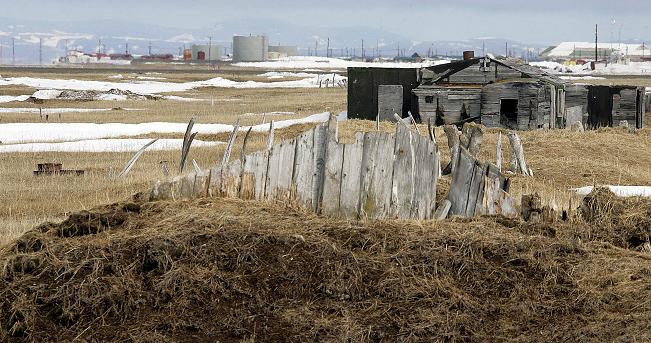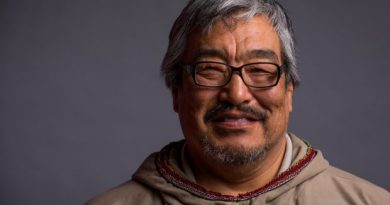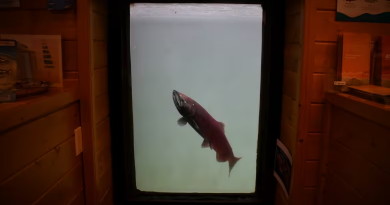Villagers suspect nuclear devices buried in Arctic Alaska

As the Department of Energy moves to clean up remnants of Project Chariot — a Cold War-era scheme to create a deepwater harbor in Northwest Alaska using nuclear blasts — residents from a village near the proposed harbor say they’re still being lied to about nuclear bombs they believe were secretly buried and never removed.
“They’re trying to cover this up,” said Jack Schaefer, mayor of Point Hope, an Inupiat village of about 700 on the edge of the Arctic Ocean. “The concerns we have are that (nuclear) devices that were placed in there, and they’re saying, ‘Don’t worry, be happy.’”
The project in the late 1950s and early 1960s was part of Operation Plowshare, an effort to showcase peaceful uses of nuclear power. Capitalizing on dubious claims it would spark Arctic development, Edward Teller and other scientists planned to detonate a string of underground bombs near Cape Thompson, about 30 miles southeast of Point Hope, blasting open a crater to form the harbor.
Those explosions never occurred, thanks in part to strong opposition from Point Hope, whose residents used the area for subsistence hunting. Their resistance ultimately helped spark the environmental movement in Alaska and began to unify Alaska Natives statewide for the first time.
Officials with the Department of Energy say the bombs, and the equipment needed to get them into the earth, never came to the site.
Cleanups since 1990
But some in the village believe the federal government buried the bombs and left them to decay, their radioactive materials posing a health threat in a village where cancer is said to be the leading cause of death.
Since 1990, the government has conducted cleanups to remove pollution associated with the years of preparation for the project, as scientists studied the terrain and planned for the blasts.
The latest step in the long-running clean-up calls for the Department of Energy to have a contractor seal and abandon four holes near the mouth of Ogotoruk Creek that the agency says were drilled to test permafrost. A fifth hole — drilled to house a proof-of-concept cratering blast using high explosives but not nuclear devices — is also set to be cleaned up. The work will begin late this summer and will be done in accordance with state of Alaska regulations, officials said.
The cratering test never occurred at that hole. But diesel was used in the drilling mud for all five holes, contaminating the soil. That soil will be removed and shipped to a permitted landfill in the Pacific Northwest for disposal, said Mark Kautsky, head of the project for the DOE’s Office of Legacy Management in Grand Junction, Colo.
Some fear the federal government wants to leave weapons buried forever near Point Hope.
“We need to get those atomic bombs out of there,” said Earl Kingik, an environmental activist from the village. “They cleaned it up before, but they left the bombs behind.”
Freedom of Information Act
Schaefer, Kingik and others say they’ve seen evidence the bombs were brought to the region and buried, including blueprints acquired by the village under the Freedom of Information Act, showing that test holes were larger than the federal government claims, large enough to fit a bomb. Many other documents remain classified.
“They won’t say because it’s top secret,” said Kingik. “Point Hope wants to hear from the government.”
That will happen on Monday, when officials with the Department of Energy’s Office of Legacy Management, as well as the U.S. Army Corps of Engineers, which is helping manage the project in Alaska, travel to the village for a public meeting about the upcoming work.
Kautsky said the five boreholes were far too small to hold the huge bombs of the early 1960s. Historical documents show the equipment needed to mine and place a bomb deep into the earth never came to Alaska, he said. Aerial photos show large-scale earthwork was never done.
“We feel quite confident nothing like that ever happened,” he said.
Still, Kautsky said he can see why Point Hope is concerned bombs may be buried.
“I completely understand the villagers’ distrust of the federal government. They’ve been told a story so many times that turned out to be a lie. It embarrasses me to be involved with the federal government when I hear about things like this.”
Pollution concerns
One of the biggest secrets wasn’t known for decades: Soil contaminated by a 1962 nuclear blast in Nevada was brought to the site and buried to test the mobility of radioactive elements in the soil and water. The “tracer tests” were discovered 30 years later in declassified documents obtained by Dan O’Neill, author of “The Firecracker Boys” — a book chronicling the Project Chariot saga — Kautsky said.
“The local population was rightly so outraged, so the question is how many more things are out there that the federal government has never adequately explained,” said Kautsky.
Kautsky said four of the test holes were just two inches in diameter, about the size of the pipes under a kitchen sink. The thermistor cables for testing permafrost remain, and the end of the pipes, now rusted, still jut from the ground. The fifth hole for the cratering test was 8 inches in diameter – still too small for an old nuclear device.
“These things are not small,” he said, referring to nuclear devices in the early 1960s. “They were huge at that time. You’ve seen Fat Man, Little Boy,” he said, referencing the types of bombs used against Japan at the end of World War II. “You don’t fit them into a 2-inch diameter bore hole. You don’t fit them into an 8-inch diameter bore hole.”
John Kelley, University of Alaska Fairbanks professor emeritus and chemical oceanography expert, said he chaired a longtime science advisory committee for the North Slope Borough that studied the issue at least three times beginning in 1981.
The committee never found any evidence that nuclear devices were brought to the area, he said.
“A tremendous amount of money was spent in chasing ghosts, and reports that the science committee wrote were all negative,” he said. “(Each report) always seemed to quell things for a while, then the issue would come up again.”
Still, there’s evidence, residents said. That includes the statement of a Nuiqsut villager made as he died of cancer that he witnessed the effort to lower nuclear devices into the ground. Also, documents reference the contents of crates that were brought to the area and contained several thousand pounds of unspecified materials.
Also, a top military official once accidentally admitted in a meeting that the bombs were left behind, said George Edwardson, vice president of the Inupiat Community of the North Slope, a regional tribal group on the North Slope based in Barrow.
“There are bombs there,” said Edwardson, whose daughter, Rachel Edwardson, has produced a documentary about Project Chariot and its effect on the village.
George Edwardson said he will travel to Point Hope for the meeting. “There will be cover-ups if I’m not there,” he said.
Contact Alex DeMarban at alex(at)alaskadispatch.com
Related Link:
United States: Film examines legacy of 1950s nuclear project in Arctic Alaska, Alaska Dispatch



